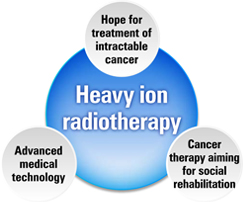What is heavy ion radiotherapy?
Minimally invasive therapy that preserves the body's functions, for improving patients' QOL and social rehabilitation
Radiotherapy that offers hope for an effective treatment of intractable cancer resistant to other forms of radiotherapy and chemotherapy
Heavy ion radiotherapy uses carbon ion beams that are accelerated to approximately 70% of light speed. Basic studies and clinical research on this therapy are being advanced in Japan and other countries. Owing to its high cytolethality, heavy ion radiotherapy can offer hope for an effective treatment of cancer deep in the body, or intractable cancer that is resistant to conventional radiotherapy.

Cancer therapy aiming for patients' social rehabilitation
Due to progress in medical science, the recovery rate for cancer patients has increased. However, it is not enough for medical professionals simply to cure cancer patients: they are required to attach importance to the patient's QOL and social rehabilitation during the treatment. Compared with conventional radiotherapy, heavy ion radiotherapy is more outstanding, because of its higher dose concentration, its conservation of the treated organ and the surrounding tissue, and, in favorable cases, preserving the functions of the treated areas. Heavy ion radiotherapy is characterized by painlessness and short period of treatment, which can reduce the burden on the patient.
Radiotherapy approved as advanced medical technology by the national government
As part of the national First-Term Comprehensive Ten-Year Strategy for Cancer Control, the world's first medical heavy ion beam accelerator, called HIMAC, was constructed in the National Institute of Radiological Sciences (NIRS), and its clinical trials began in 1994. In October 2003, heavy ion radiotherapy was approved by the national government as a "highly advanced medical technology" (now referred to as "advanced medical technology").
From April 2016, some cancers are covered by Insurance, heavy ion radiotherapy continues to gain recognition as an important cancer therapy in Japan.
Now in Japan, seven heavy ion radiotherapy facilities are operating and over 43,000 patients have already been treated (as of end of 2023).
Encouraging the worldwide use of heavy ion radiotherapy by downsizing of the system
The most important challenge facing the spread of heavy ion radiotherapy is the land and associated cost required for the construction of the irradiation facilities. Therefore, R&D was advanced to downsize the equipment, and the first compact heavy ion radiotherapy facility for widespread use commenced operations at Gunma University.
At the Kanagawa Cancer Center Heavy Ion Radiotherapy Facility (i-ROCK), heavy ion radiotherapy is conducted using the high-speed 3D scanning irradiation method, which makes it possible to suppress damage to the normal tissue around the cancer lesion more than ever.
Moreover Yamagata University is using small gantry with superconducted magnet which makes patients friendly circumstances for treatment.















